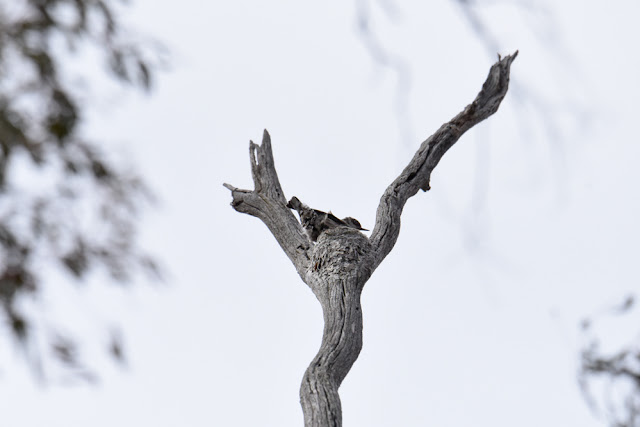Acrodipsas myrmecophila

Small Ant-blue butterflies are indeed small.
Although when they fly in swarms like this one, in which there were of over a hundred individual males, they are spectacular.
This is the tree they were flying around, a small Blakeley's Red Gum sapling, with some dead wood lying around, in an open grassy woodland on the edge of the suburbs. The butterfly is a rare resident in the Canberra area, and is uncommon or very localised throughout its range from Victoria to southern Queensland.
Here a group of four adults (all male) have newly emerged from the ant nest they have developed within and overwintered as larvae. The ants are Coconut Ants Papyrius nitidus, and the butterfly larvae feed on their larvae. The ants build their nests in dead wood lying on the ground and in the base of the saplings.
Once their wings are fully extended they begin flying around the nest trees and perch on the branches and leaves, ever watching or smelling for females.
When a few days old, the fringes are tattered and the wings themselves become chipped and ragged. The metallic blue of the bronze upperwing shows in this photo.
Two males perched on my watch as I was photographing the flock. They seldom sit with their wings open for more than a few seconds.
The females were scarcer and seemed to mate as soon as they could fly. The next time they became obvious was when they were seeking a crevice or shady piece of bark at the lower parts of a sapling to lay their eggs in.
I never saw a female sit with her wings open and this one only shows a glimpse of the bright metallic blue of her upperwing.
Once they have laid their eggs the females die. Or in this case are immediately killed and dismembered by the ants. How did the ants know to let her lay her eggs before attacking her. They were in attendance all the time she was laying. The blue of her wings is more easily seen now.
The males probably live for a week of so, competing to mate with a female, but they too can become prey. This one flew into a spider's web, she can be seen top right. Other males were caught by birds, such as Noisy Miners which had a nest in the ant-tree.
The whole flying season probably only lasts for a one or two weeks. Then once the adults have died, the species continues as several instar stages within the ant nest until the next generation emerges the following year. But what do the ants gain from the partnership? or are they simply conned by some pheromone emitted by the butterflies and larvae?


















































